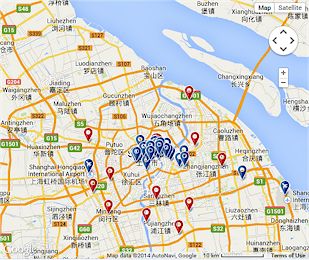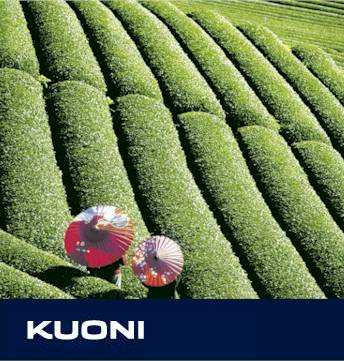« CHINA • DISCOVER CHINA • Shanghai
Discover magical Shanghai

Shanghai is a popular tourist destination renowned for its historical landmarks such as The Bund, City God Temple and Yu Garden as well as the extensive Lujiazui skyline and major museums including the Shanghai Museum and the China Art Museum.
A | B | C | D | E | F | G | H | I | J | K | L | M | N | O | P | Q | R | S | T | U | V | W | X | Y | Z
» Bund Sightseeing Tunnel
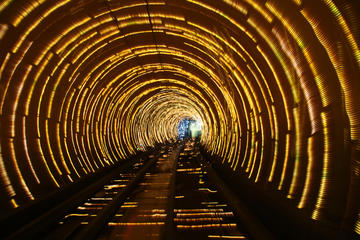
Since its opening in 2000, the Bund Sightseeing Tunnel has become one of Shanghai’s most popular attractions among domestic tourists. Contrary to what the name would have you believe, you won’t be seeing any of the Bund’s sights when you ride the automated subway car from the Bund beneath the Huangpu River to Pudong on the other side. This rather bewildering by nonetheless entertaining trip takes less than five minutes …
» Classical Gardens of Suzhou
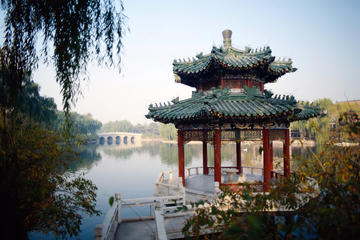
The art of the traditional Chinese garden was popular among wealthy Chinese during the Ming and Qing Dynasties, and nowhere is the classic beauty of these gardens more evident than in Suzhou, a city located 50 miles (81 kilometers) northwest of Shanghai. Once the private retreats of families living in Suzhou, the gardens that survived the cities whirlwind modernization -- several of them making up a UNESCO World Heritage Site known as the Classical Gardens of Suzhou …
» Duolun Road

Duolun Road is a must-see stop for those interested in the history and culture of Shanghai in the 1920s and 1930s. It was once a writers' enclave and today has been restored as a 'cultural street.' Duolun Road was once part of the American Concession, and the restored 20th century architecture is the main reason for visiting. The area has been pedestrianized; you'll wander among museums, antique and curio houses, calligraphers' and painters' studios …
» Huangpu River
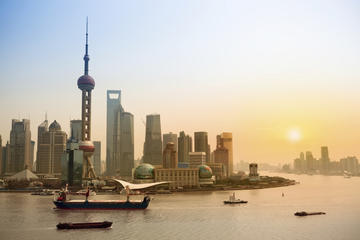
The Huangpu River, extending over 71 miles, flows through the middle of Shanghai’s, dividing the city into two parts – Pudong to the east and Puxi to the west. The port where the river empties into the East China Sea has now become the largest port in China and in 2012 became the world’s busiest container port. Walking along the Huangpu River juxtaposes the colonial buildings of Old Shanghai with the towering, ultramodern skyscrapers …
» Jade Buddha Temple (Yufo Si)
Yufo Si is a working Buddhist community - one of the few in China - but the star attractions of the Jade Buddha Temple are two figures brought to Shanghai by a Burmese monk in the 19th century. The most impressive is the sitting Buddha, a 1.9 m (6.5 ft) giant encrusted with semi-precious stones. This Buddha is sitting in the pose which captures the moment of his enlightenment by meditation. The other Buddha is smaller and in the attitude of 'happy repose' …
» Jin Mao Tower
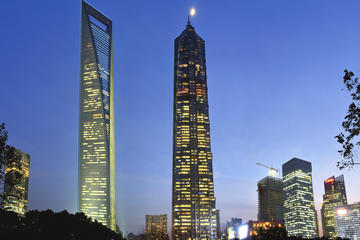
There are few more potent symbols of Shanghai's drive to go stratospheric than the Jin Mao Tower. In fact, there's only one. Jin Mao is the city's second-highest skyscraper (the highest is the nearby Shanghai World Finance Center), and ranks up there in the list of the world's tallest buildings. It clocks in at 421 m (1,381 ft). The architecture of the 'Golden Prosperity Building' gestures at both the Western skyscraper and the Chinese pagoda …
» Lupu Bridge
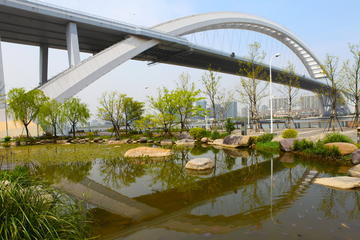
Shanghai’s Lupu Bridge, the world’s first steel arch bridge and the second longest arch bridge after the Chaotianmen Bridge in Chongqing, extends 5.4 miles across the Huangpu River. Built in 2000, the bridge caught the attention of the engineering world with its use of cable-stayed, arch and suspension bridge technology. While the bridge is primarily used for transportation -- six lanes of traffic move across it and large ships can pass beneath unobstructed …
» Nanjing Lu (Nanjing Road)
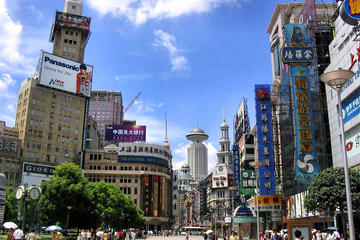
Nanjing Lu (Nanjing Road) is a shopping street with a history. When the British began trading in Shanghai after the Opium Wars of the 19th century, this was one of their commercial centers. In those days it was called Nanking Road, the 'k' being a more popular form of Anglicization. Today it's not only the hectic heart of Shangai's shopping and tourism scene, but the longest shopping district in the world (6 km/3.5 mi of go-go-go) …
» Ohel Moshe Synagogue
The Ohel Moshe Synagogue (Ohel Moishe) played a central role in the lives of Jewish refugees in Shanghai during WWII. Although the synagogue is no longer fully in use, a section of it has been given over to house the Shanghai Jewish Refugees Museum. In the 1930s, Shanghai was one of the only cities in the world giving shelter to the Jews fleeing Nazi persecution in Europe. When the city was occupied by the Japanese, the Germans put pressure on their allies …
» Old French Concession
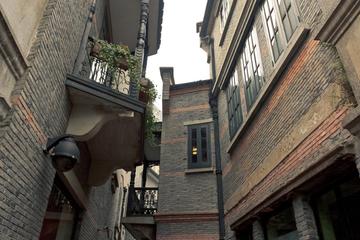
Shanghai’s Old French Concession, an area once leased to the French in the Luwan and Xuhui districts of the city, is a reminder of an older Shanghai. The visitor-friendly area is packed full of beautiful colonial mansions and hotels dating back to the first three decades of the twentieth century. The French took control of the area in 1849, but it wasn’t until the 1920s when the neighborhood reached its peak of popularity as one of Shanghai’s most elite neighborhoods …
» Oriental Pearl Tower
The Oriental Pearl TV Tower once used to be the highest building in Shanghai, and it's still up there. It's certainly one of the most hyperbolic and striking features of the horizon. Many people hate it; others have developed an odd affection for its bulbous form. The design aside (it has been compared to the sound of pearls, large and small, dropping onto a jade plate - a conceit borrowed from a poem), the tower has some pretty impressive stats …
» People’s Square (Renmin Guang Chang)
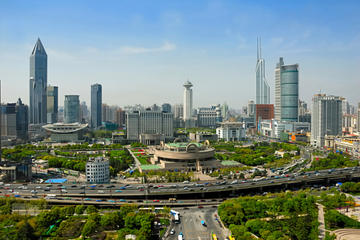
Located in the heart of Shanghai, People’s Square (Renmin Guang Chang) is the home to the city’s municipal government headquarters and, more importantly, serves as a major landmark and meeting point in Shanghai. What was once an elite horse racing venue before the establishment of the People’s Republic of China in 1949 is today a hotspot of cultural attractions. Within People’s Square, you’ll find some of the best museums in Shanghai …
» Pudong
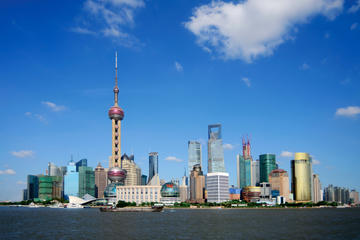
Pudong, the area of Shanghai east of the Huangpu River, is home to many of Shanghai’s most famous modern buildings. Formerly an agricultural area, Pudong is now Shanghai’s financial district and commercial hub -- a stark contrast to the colonial buildings of the Bund just across the river. Pudong’s skyline includes notable buildings like the Oriental Pearl Radio and TV tower, Jinmao Tower Observatory, Shanghai Ocean Aquarium and the International Convention Center …
» Shanghai History Museum

Located in the basement of the Pearl TV tower, the Shanghai History Museum displays more than 30,000 cultural relics and artifacts covering 100 years of Shanghai’s modern history, from the opening of the port of Shanghai to the world in 1843 to the Cultural Revolution in 1949. If you’ve ever wondered what Shanghai might have looked like before its massive modernization, head down to the basement level of the museum, where you’ll find wax dioramas depicting street scenes from Shanghai’s past …
» Shanghai Maglev

If you’ve ever wondered what it feels like to travel at speeds upward of 260 miles per hour (418 kilometers per hour), the Shanghai Maglev train is your chance. Using magnetic levitation technology that allows the train to literally “float” along the tracks, the world’s fastest train can take you from the Pudong International Airport to Shanghai proper in a quick 8 minutes. Using technology purchased from Germany, construction of the Shanghai Maglev began in 2001 …
» Shanghai Museum (Shanghai Bowuguan)
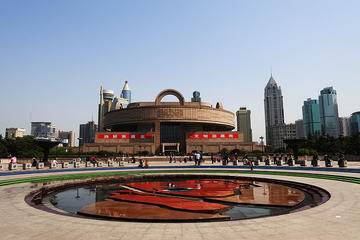
The first thing to note about the Shanghai Museum (Shanghai Bowuguan) is its unusual design. The building, constructed in the 1990s, is supposed to resemble an ancient type of bronze cooking pot called a ding. It's a reference to the objects on display in the museum's five stories of rooms. The museum's structure - a round building on a square base - also holds echoes of China's history. Ancient buildings in China were constructed like this because of the belief that heaven was round and the earth square …
» Shanghai Old Town (Nanshi)
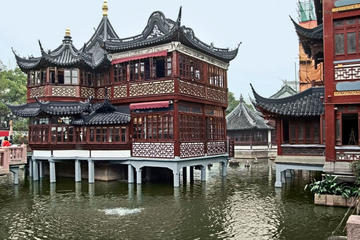
At first glance the Old Town of Shanghai might seem like just another tourist trap, but Nanshi, as it used to be called (or Southern Town as most of the residents of the city call it) has a genuinely fascinating history. This part of town predates the colonial presence in Shanghai. It's bordered by Renmin Lu and Zhonghua Lu, roads that echo the line of walls built in the 15th century to keep out Japanese pirates and since demolished …
» Shanghai Temple of the Town God (Chenghung Miao)
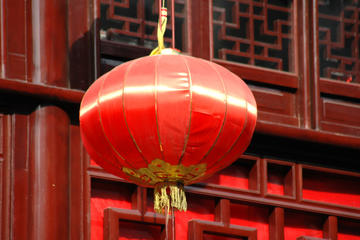
The Shanghai Temple of the Town God (Chenghung Miao), located in the walled portion of Old Shanghai next to the Yu Gardens, is an orthodox Taoist temple dedicated to three local deities or “city gods,” General Huo Guang, scholar Qin Yubo and General Chen Huacheng. Almost every city in China has a Town God temple, and Shanghai’s dates back to 1403. It was converted into a City God temple in 1403 during the Ming Dynasty …
» Shanghai Urban Planning Exhibition Hall
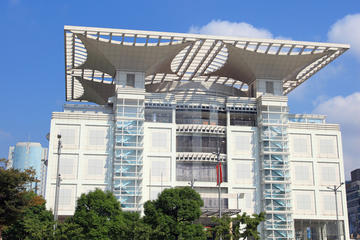
Located within People’s Square, the Shanghai Urban Planning Exhibition Hall may not sound like something a tourist would be interested in, but it’s actually one of the city’s best museums. Opened in 2000, the exhibition space within the modern, fives-story building showcases Shanghai’s development from ancient times well into the future. The museum’s crowning jewel is a massive scale model of the city as it might look come 2020 …
» Shanghai Xin Tian Di
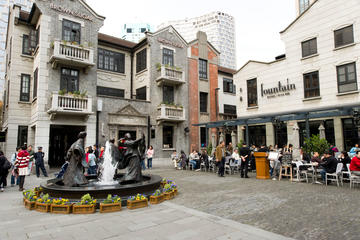
Xin Tian Di (Xintiandi) is a sleekly restored area of Shanghai, where the more successful of the city's young come to play. It's also a popular strolling area for tourists, who like to check out the 19th century architecture. The district abounds in shikumen, stone houses that were a popular residential form in the late 19th century and early 20th century city. When the districts that contained these houses were being razed, developers stepped in to save and restore this area …
» Suzhou and Zhouzhuang
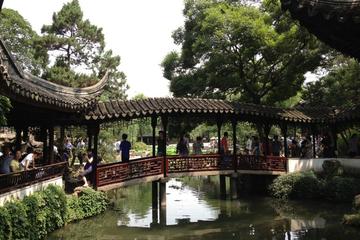
If Shanghai's ultramodern skyline has you pining for the China of old kung fu movies, a day trip or weekend in Suzhou or Zhouzhuang might be in order. Both described individually as 'the Venice of China,' the two cities' lantern-lined canals and traditional architecture make them quite photogenic and well worth a visit. Zhouzhuang, the oldest of China's water villages, sits about a 90-minute bus ride from Shanghai halfway between Shanghai and Suzhou …
» The Bund (Waitan)
The Bund (or Waitan) is the grand center of Colonial architecture in Shanghai. The former International Settlement runs along the waterfront of the Huangpu River, facing the Pudong district ('Bund' is a word of Indian derivation meaning 'embankment'). When foreign powers entered Shanghai after the Opium Wars of the 19th century, the Bund existed as a towpath. It quickly became the center of Shanghai as Western traders built banks …
» World Financial Center Building
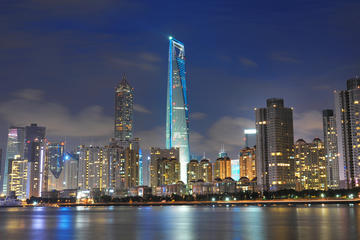
The single tallest building in Mainland China (and that’s saying something, considering its proximity to the massive Jin Mao Tower), the Shanghai World Financial Center (SWF) is a truly astonishing feat of modern engineering. Unlike many other contenders in the race for the title of World’s Tallest Building, SWF is almost completely office and commercially accessible. No mere spire or towering antenna, this building was designed by Kohn Pedersen Fox …
» Yuyuan Garden
The name of the Yuyuan Garden means 'Garden of Peace and Comfort', a slightly ironic moniker these days. Owing to its position in the center of the Old Town and its reputation as one of China's finest and best-preserved gardens, Yuyuan is crowded to bursting point every day. And yet, somehow, it manages to maintain something of its air of serenity. The garden has a touching history. It was built in the 16th century by a government official …
» Zhujiajiao
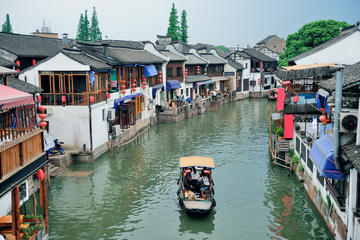
For a genuine experience that not only show you the history of China, but also showcase its beauty, try a visit to China’s great ancient water town known as Zhujiajiao. Formed over 1,700 years ago, this wonderful canal laden town that was once an important trading hub, has seen the days of both the Yuan, Qing and Ming dynasties, and has flourished today as a an up-and-coming bohemia of Asia. In order to truly have an understanding of this beautiful place …
« CHINA • DISCOVER CHINA • Shanghai





